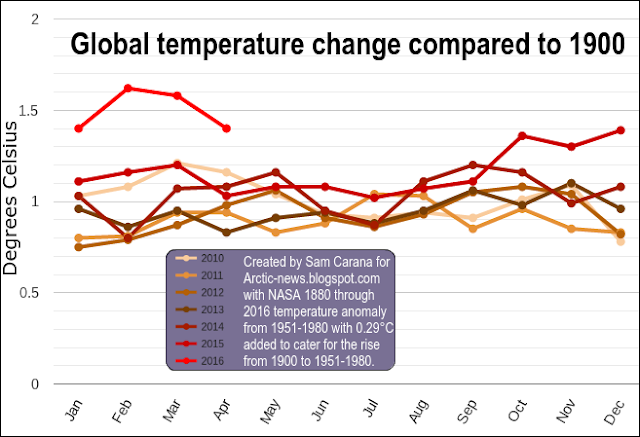 |
| 0-2000 m Global Ocean Heat Content |
This year (from January to April 2016) on the Northern Hemisphere, oceans were 0.85°C or 1.53°F warmer than the 20th century average.
The image below illustrates that temperatures look set to be high in Siberia for the coming week. The panel on the right shows anomalies at the top end of the scale in Eastern Siberia on June 5, 2016, while the panel on the right shows a forecast for June 12, 2016.
These high air temperatures are causing feedbacks that are in turn further speeding up warming in the Arctic.
This is illustrated by the images below. The image directly below shows temperatures in Eastern Siberia as high as 29.5°C (85°F) on June 5, 2016, at a location close to the coast of the Arctic Ocean (green circle).
High air temperatures come with increased risk of wildfires, as illustrated by the image below showing carbon monoxide levels as high as 2944 ppb on June 4, 2016 (at green circle).
The satellite image below zooms into the area with these high carbon monoxide readings, showing wildfires on Kamchatka Peninsula on June 3, 2016.
High air temperatures in the Arctic are very worrying, as they can trigger a number of important feedbacks, including:
- Changes to Jet Streams. As the Arctic warms more rapidly than the rest of Earth, changes are occurring to the jet streams. As a result, winds can increasingly bring hot air far to the north, resulting in further loss of the Arctic snow and ice cover, in turn further warming up the Arctic.
- Warmer Rivers. High air temperatures cause warming of the water of rivers that end up in the Arctic Ocean, thus resulting in additional sea ice decline and warming of the Arctic Ocean all the way down to the seabed.
- Wildfires. High air temperatures set the scene for wildfires that emit not only greenhouse gases such as carbon dioxide and methane, but also pollutants such as carbon monoxide (that depletes hydroxyl that could otherwise break down methane) and black carbon (that when settling on ice causes it to absorb more sunlight).
- Soil destabilization. Heatwaves and droughts destabilize the soil. Soil that was previously known as permafrost, was until now held together by ice. As the ice melts, organic material in the soil starts decomposing, resulting in emissions of methane and carbon dioxide, while the soil becomes increasingly vulnerable to wildfires.
- Buffer Loss. Arctic snow and ice cover acts as a buffer, absorbing heat that in the absence of this buffer will have to be absorbed by the Arctic Ocean.
- Albedo Change. Arctic snow and ice cover also make that more sunlight is reflected back into space. In the absence of this cover, the Arctic will have to absorb more heat.
How rapidly can things eventuate?
Professor Peter Wadhams, head of the Polar Ocean Physics Group at Cambridge University, says: “My prediction remains that the Arctic ice may well disappear, that is, have an area of less than one million square kilometres for September of this year.” Warming due to Arctic snow and ice loss may well exceed 2 W per square meter, i.e. it could more than double the net warming now caused by all emissions by people of the world, Peter Wadhams calculated in 2012.
Peter Wadhams further co-authored a study that calculated that methane release from the seafloor of the Arctic Ocean could yield 0.6°C warming of the planet in 5 years (see video interview of Thom Hartmann with Peter Wadhams below).
The two feedbacks mentioned by Peter Wadham (albedo and seafloor methane) are are depicted in the image below.
 |
| for further discussion, see the feedbacks page |
In total, warming could exceed 10°C (18°F) within one decade, assuming that no geoengineering will take place within a decade, as discussed in earlier posts such as this one.
The situation is dire and calls for comprehensive and effective action, as described at the Climate Plan.
Links
- Feedbacks in the Arctic
http://arctic-news.blogspot.com/p/feedbacks.html
- East Siberian Heatwave
http://arctic-news.blogspot.com/2015/07/east-siberian-heat-wave.html
- Wildfire Danger Increasing
http://arctic-news.blogspot.com/2016/05/wildfire-danger-increasing.html
- Albedo changes in the Arctic
http://arctic-news.blogspot.com/2012/07/albedo-change-in-arctic.html
- Three kinds of warming in the Arctic
http://arctic-news.blogspot.com/2016/02/three-kinds-of-warming-in-arctic.html
- Arctic could become ice-free for first time in more than 100,000 years, claims leading scientist
http://www.independent.co.uk/environment/climate-change/arctic-could-become-ice-free-for-first-time-in-more-than-100000-years-claims-leading-scientist-a7065781.html
- Greenhouse gas levels and temperatures keep rising
http://arctic-news.blogspot.com/2016/01/greenhouse-gas-levels-and-temperatures-keep-rising.html
- Arctic Methane Release: "Economic Time Bomb"
http://arctic-news.blogspot.com/2013/07/arctic-methane-release-economic-time-bomb.html
- February Temperature
http://arctic-news.blogspot.com/2016/03/february-temperature.html
- Ten Degrees Warmer In A Decade?http://arctic-news.blogspot.com/2016/03/ten-degrees-warmer-in-a-decade.html
- Climate Plan
http://arctic-news.blogspot.com/p/climateplan.html
























































